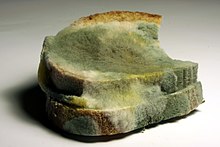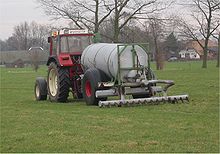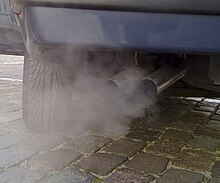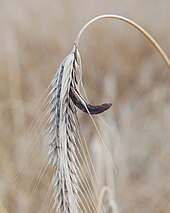Pollutant
In everyday usage, pollutants are substances or mixtures of substances present in the environment that can be harmful to humans , animals , plants or other organisms and entire ecosystems . The damage can be caused by uptake by organisms or entry into an ecosystem or its biomass. A substance is defined as “harmful” in a narrower sense because of its effect on an ecosystem (from microorganisms to plants, animals and humans).
However, this definition also shows the difficulty in defining this term. A certain, chemically defined substance ( substance ) cannot always be clearly assigned to the category pollutant (or toxic substance) or excluded from it, but it also depends on the quantity and the surrounding situation. The effect of a pollutant (as well as a poison ) on an ecosystem must therefore be investigated and documented by field tests , long-term experiments and pollutant analyzes in the form of qualitative detection reactions and quantitative instrumental measurements.
Natural and artificial pollutants
There are basically two groups of pollutants:
- natural pollutants - such as rock - dust or mycotoxins (fungal toxins) - and
- artificial pollutants - of anthropogenic origin, i.e. caused or released by humans .
Both groups can have chemically different substances, organic or inorganic , but also strong structural differences and be composed of particles of different sizes.
Therefore, pollutants are also divided according to other aspects:
- Agriculture pollutants
- Pollutants from environmental pollution
- Pollutants from improper storage, preparation and disposal
- Pollutants of natural origin
Agriculture and horticulture pollutants
Possible pollutants here would be:
- Pesticides such as B. DDT or hexachlorobenzene (HCB) are used by farmers for pest control and can have harmful effects, especially if they are washed into groundwater or surface water , as they are toxic, teratogenic , carcinogenic or mutagenic to many organisms and are often very persistent .
- Nitrogen fertilization (for example with liquid manure ) can, among other things, introduce nitrates into the groundwater or into food. These nitrates are metabolized to nitrites in the body and can impair the transport of oxygen ( methaemoglobinaemia ); cyanosis can occur in babies . In addition, nitrite and proteins can produce nitrosamines , most of which are classified as carcinogenic.
- Many mineral fertilizers contain phosphate fertilizers , which have a natural content of uranium and cadmium . These pollutants can accumulate in the soil and also get into the groundwater.
Traffic-related pollutants
Cars, trains, trucks, motorbikes, shipping
Car traffic, rail traffic, lorry traffic, motorized motorcycle traffic and ship traffic release pollutants. A distinction must be made between the exhaust gases produced during the combustion process and the fine dust produced by abrasion of the tires , the road surface and the brake pads .
The concentration of pollutants in the exhaust gases can be reduced using technical processes. In the European Union , it is regulated by the emissions standard . Since January 1, 2005, the Euro 4 standard has been in force across Europe for new passenger vehicles.
The fine dust pollution caused by abrasion can only be reduced to a limited extent by technical measures.
Air traffic
Aircraft spread their exhaust pollutants into the upper atmosphere .
Pollutants from improper storage and preparation
Incorrect storage of food allows microorganisms to multiply well, so that they metabolize pollutants such as aflatoxins , patulin or ergot alkaloids .
But even without the influence of living beings, pollutants can form in food over time, for example through UV radiation .
Pollutants in tobacco smoke
In general, a distinction must be made between the pollutants in the inhaled smoke (mainstream smoke) and the pollutants in the smoke at the tip of the cigarette (sidestream smoke). The pollutants in sidestream smoke are many times stronger than in inhaled and exhaled mainstream smoke, because the combustion temperature of inhaled smoke is higher, the inhaled smoke is usually filtered and some of the pollutants also remain in the lungs of the person who smokes.
Depending on the amount of cigarettes smoked, there are pollutant concentrations in closed rooms that can have serious consequences for non-smokers too. The smallest closed space is usually the car , sometimes a train compartment.
The pollutants in cigarette smoke / passive smoke (sidestream smoke)
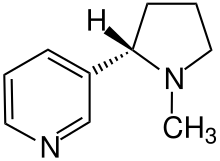
Since the temperature of a smoldering cigarette drops quickly after each puff, the ingredients burn unevenly well. In addition, the smoke emanating from the tip reaches the environment unfiltered. This so-called sidestream smoke or passive smoke pollutes the ambient air with an abundance of pollutants that affect smokers and non-smokers alike and poison them comparatively hard.
Pollutants in passive smoke or sidestream smoke
- Carbon dioxide : 8 to 11 times more
- Carbon monoxide : 3 to 5 times more
- Nicotine : 3 times more
- Phenol (carcinogenic): 2 to 3 times more
- Formaldehyde (carcinogenic): up to 50 times more
- Benzene (carcinogenic): 5 to 10 times more
- Fine dust / dust particles (carcinogenic, with PAH ): 2 times more
Additives in cigarettes
The cigarette industry and the tobacco industry in general have had the right in Germany since 1977 to add (food) additives to smoking products. These additives can form other carcinogenic substances when burned .
Pollutants of natural origin
There are also pollutants that arise in nature. The spectrum ranges from poisons from various plants to far-reaching sources of pollution such as volcanoes , which emit sulfur dioxide and large amounts of dust , among other things . When forest fires occur also among other pollutants such as carbon monoxide, tar-like substances and phenols .
Further examples:
- Hydrocyanic acid in almonds, fruit stones and nuts
- Lectins in raw beans, "sticky" red blood cells (erythrocyte agglutinating)
- Oxalic acid in spinach, rhubarb and beetroot , it can contribute to kidney stone formation
- Solanine (Solanum Steroid Alkaloid Glycoside) in green sprouted potatoes and unripe tomatoes
- Asbestos fibers as a component of rock containing serpentine and hornblende
- Radon as a radioactive emission source from rock
Breakdown of the pollutants
Outline according to the chemical process

Inorganic pollutants: elements, molecular and salt-like compounds (from chemical substance classes such as heavy metals , salts , acids , alkalis and by origin):
- (a) Of natural origin - volcanic matter, rock dust .
- (b) Of anthropogenic origin - how many shares in fine dust , in artificial fertilizers or various nitrogen oxides and heavy metals .
However, the latter can also be of natural origin, in that they come from polluted soil or, for example, from volcanic activity and thus end up in the food chain or the air .
Organic pollutants: hydrocarbons (saturated and unsaturated aliphatic and aromatic ), substituted hydrocarbons, such as CFCs , carboxylic acids , nitrogen bases and toxins (toxins) and similar - which in turn often all in the categories themselves naturally and artificially classified can be divided
- (a) Natural organic pollutants - toxins from fungi and other biological organisms
- (b) Anthropogenic organic poisons such as PCB and DDT .
The former could also include airborne particles such as pollen or cat hair if they cause allergies in some people (potential pollutants).
Structural classification of the pollutants
Pollutants usually exist in the form of mixtures of substances . In the case of solid pollutants, the diameter of the particles is important because it is decisive for the distribution, turbulence and possible expectoration from the lungs . The cohesion of the particles and other structural properties are also important.
One can differentiate between the physical state and structure:
- elongated structures ( hair , hairs, asbestos fibers )
- Dust (solid particles from 0.01 mm to about 0.5 millimeters)
- Fine dust (particles below 10 µm, smoke or aerosol swirls in air )
- Liquid droplets in the form of vapor or mist made up of molecules of different sizes, possibly also as a coating on dust particles (as in tar fumes and tobacco smoke ) or in aqueous solution or emulsion .
- Gases (such as the air pollutants nitrogen dioxide , carbon monoxide , sulfur dioxide , CFC )
Pollutant in criminal law
Germany
In Germany , the German Criminal Code (StGB) describes in Section 324 to Section 330 criminal offenses against the environment. According to this, it is a criminal offense to release substances to an extent that is appropriate
- to harm the health of another, of animals, plants or other things of significant value or
- to permanently pollute a body of water , the air or the soil or to otherwise disadvantageously change it.
See also
literature
- Müller, German (1983): On the chronology of pollutant input into water. Geosciences in our time; 1, 1; 2-11; doi: 10.2312 / geosciences.1983.1.2 .
Web links
- Lists of additives in tobacco products tobacco (Federal Ministry for Food, Agriculture and Consumer Protection, 2005)
- GLOBAL 2000 - Poison in Water - Pesticides, Nitrate, Lead ( Memento from February 4, 2009 in the Internet Archive )
- Pollutant analysis in the laboratory, information on analysis in mycology, bacteriology and entomology ( Memento from June 17, 2008 in the Internet Archive )
Individual evidence
- ↑ Habermehl: The importance of mycotoxicoses for humans and animals. In: German veterinary weekly. 1989, pp. 335-338.
- ↑ Uwe Leiterer: Poisonous uranium in garden fertilizers ( Memento from May 11, 2012 in the Internet Archive ), at ndr.de
- ↑ Patrick Steinle, Markus Schafer, Paul Roth: Release of asbestos fibers and other elongated mineral particles when working on serpentinite rock - emission tests and differentiated analytical assessment. In: Hazardous substances - cleanliness. Air . 76, No. 5, 2016, ISSN 0949-8036 , pp. 173-182.
- ↑ Pollutants in construction - background information ; Retrieved February 20, 2013.

